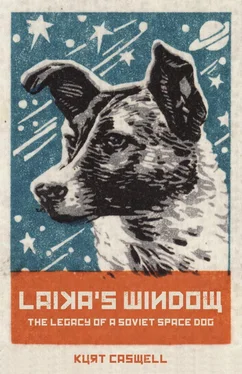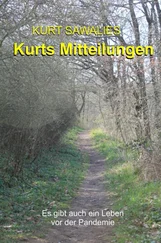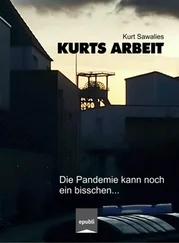Did Laika see this sight too? Did Laika see it first? And what value is there in knowing, or not knowing, that she did?
Whether she could or not, by imagining the view from Laika’s window—from the inside of her capsule looking out—perhaps we can learn more about her and more about ourselves too: who we are as a species, with our appetite for exploration and knowledge, our appetite for power too, running side by side with our compassion, our empathy, and even our love for the planet we live on.
And Laika’s story is about loneliness, about loneliness as fundamental to being human. If we can trust poet Sylvia Plath, loneliness is an assertion of our need for each other, our need for “another soul to cling to.” In clinging to another soul, we do find comfort, but we lose that comfort to partings, breakups, wars, death, as if the universe itself is so hinged as to cycle us through loneliness and comfort and then loneliness again like seasons turning across the years. These seasons of losses are the linchpins of all this loneliness, loneliness no human being can escape. In response to it, we cast our net into the cold, black cosmos, our net of satellites, telescopes, rovers, probes, spacecraft, space stations: is anything out there? Is anyone out there? And we send our dogs out too, out into the void to help us with the question we all hope to answer: are we alone in the universe? Are we special, or are we instead rather ordinary because life abounds out there? Will it one day be possible to establish fellowship with other beings on other worlds? Whether we will or not, human life is without meaning without one another, and without animals; all we have is each other. As the novelist Kurt Vonnegut stated in a 1974 commencement address, “The most daring thing is to create stable communities in which the terrible disease of loneliness can be cured.”
Laika’s story, then, is important because it draws us into an ethical relationship with animals we depend on, specifically with dogs as our companions in cosmic exploration. We are operating here in our search of the heavens at the very limit of our technological capability, and right beside us, with Laika as its apologue, is the dog, the animal with which we share a close evolutionary history. Wherever human beings go, whatever human beings do, our dogs go and do it with us. Sojourning with our dogs on the hunt for answers, even across an ocean of stars, is itself a kind of comfort. If adventure and exploration are evidence of an innate loneliness in the human animal, they are also an antidote to that loneliness. Space exploration, ultimately, may be a search for a cure for loneliness.
Finally, at its core, this book is a story about a dog. It is a biography of sorts, a portrait, a memorial. This book belongs to Laika and to all the space dogs who traveled before and after her. Through the stories of their journeys into space, perhaps we will all find ourselves a little more grounded here on Earth.
¤
In order to understand Laika’s story, it is important to come to know some of the other animals that have flown into space, who sent them and why, and what benefit, if any, resulted from their missions. It is also essential to acquaint ourselves with the stories of the other space dogs, those that flew before Laika, and those that flew after. Chapter 2, “Animals in the Heavens,” traces the story of animals in space from the earliest documented flights in hot air balloons in the eighteenth century to the animals that are part of the ongoing science aboard various satellites and on the ISS. Since the 1970s, robotic rovers and probes have mostly replaced nonhuman animal explorers and have been loosely remade in their image. While this book is not an indictment of research using animals, and it is especially not an indictment of the Soviet scientists, or any others, who launched animals into space, it does ask questions about the value of such research weighed against the suffering of the animals.
Chapter 3, “The Making of a Space Dog,” returns to the story of Laika to detail her training and includes generally the training that all Soviet space dogs endured. It also introduces Sergei Korolev, the Soviet chief designer, whose single-purpose life serves as a balefire for humanity’s entrance into the Space Age. This chapter prepares the way to better understand the specific details of Laika’s flight on Sputnik II . Chapter 4, “Scouting the Atmosphere,” features the stories of the most notable space dog flights before and after Laika. While a few of these flights rival Laika’s for achievement in endurance and advancements in technology, it is clear that she serves as a tipping point in space exploration, beyond which the dream of exploring nearby and distant planets opened into a kind of fever from which humanity has never recovered. Now that we know space travel is possible, it seems to me, we are no longer content with living solely on Earth. This chapter also brings us to the conclusion of Korolev’s story and positions him as the man who matched, if not exceeded, the achievements of the greatest minds in space exploration. Like Laika, he will forever be listed among those who did it first and those who did it best.
With these preparations, chapters 5and 6, “A Face in the Window” and “First Around the Earth,” tell the story of Laika’s flight. In these pages I have assembled—and I think for the first time—an intimate portrait of Laika: where she came from, what she endured, and what her flight means for us all. I use what is known to imagine what cannot be known: Laika’s experience inside her capsule during her time in orbit, for example. Here my purpose is not melodrama or embellishment but witness and understanding. In addition, my research brought me to an as yet unacknowledged truth about Laika’s flight and death, which I hope aids our understanding of her and our understanding of ourselves, which is this book’s main premise.
Finally, the epilogue addresses what comes next in human space exploration and draws a straight line from the aspirations of the earliest rocket scientists in the late nineteenth century, who dreamed of traveling to Mars, to Robert Zubrin and the Mars Society and Elon Musk and his SpaceX in the twenty-first century. While Laika is the Earth’s first space traveler, she was also one scout among many, sent out ahead to gather information to help us all on our journey to the stars.
TWO
¤
Animals in the Heavens
All the universe is full of the life of perfect creatures.
KONSTANTIN TSIOLKOVSKY “The Scientific Ethics,” 1930
While Laika was the first living being in orbit, she was not the first living being in space. By the time of Laika’s flight, both the Soviet Union and the United States had been experimenting for a decade with suborbital rocket flights carrying dogs and monkeys, respectively, but also fruit flies, mice, and other living things, just beyond the Karman line (100 kilometers or about 62 miles altitude) that marks the boundary of space. It was the Hungarian American physicist Theodore von Karman who first calculated that at this altitude, the atmosphere becomes too thin to support traditional flight. To navigate, and even to survive, a pilot needed a wholly new kind of craft, not an aircraft at all but a spacecraft lifted into the heavens on the nose of a rocket.
Some of these early experimental rockets carrying animals blew up on the launchpad, some turned and tumbled in the sky and blew up, some flew erratically and strayed off-course and were destroyed by charges inside the rocket detonated by a ground crew, and some rockets flew up and up into space, where they sojourned in microgravity, then turned a delicate arc back to Earth, the braking chutes deploying and slowing the spacecraft for a landing on the ground. And when the scientists and engineers arrived to retrieve those spacecraft and their animal passengers, sometimes they found them dead and sometimes they found them alive. And all of it in pursuit of science to reveal the mysterious conditions of space, and to one day give them confidence enough to risk sending the first human being off the planet. Human spaceflight, human voyages to nearby and distant planets, has always been the goal, even from the late nineteenth and early twentieth centuries when the first spacecraft designs took form in the minds of a few visionaries from Russia (later the Soviet Union), Germany, and the United States, among other countries. Sputnik II , carrying Laika, was neither the beginning nor the end. It was one step along a winding path in the exploration of the final frontier, but a giant step to be sure, one for the record books.
Читать дальше












